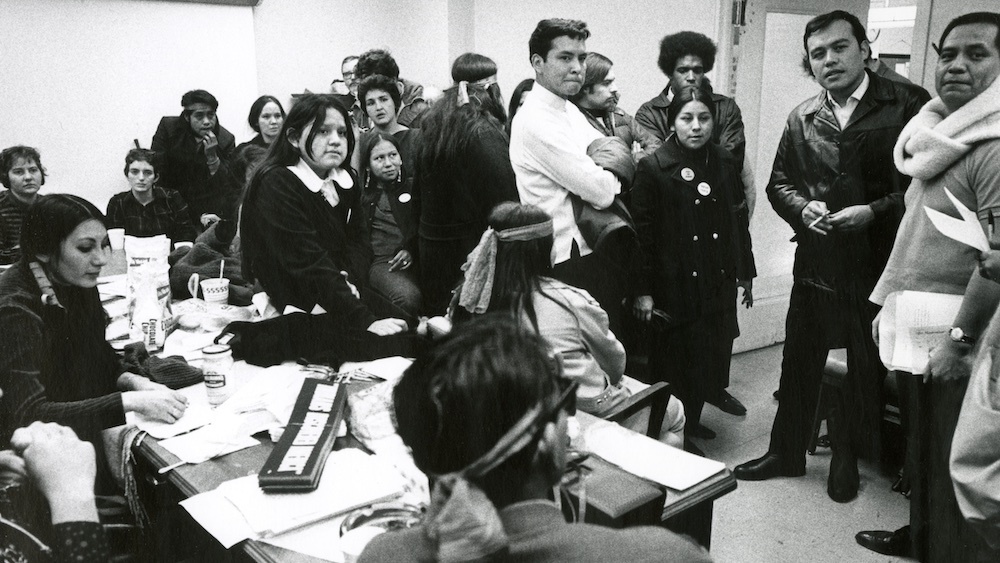
A new exhibition at the Newberry Library titled Indigenous Chicago is scheduled to close on January 4, but the expansive team of artists, cartographers, curators, historians, and scholars who produced it hope its impact extends through and beyond 2025. More than four years of planning preceded its four-month run, part of Art Design Chicago; during that development phase, more than two dozen individuals worked to deepen the project’s inquiries and move them forward.
“It’s pretty common for the Newberry to engage community stakeholders in some capacity,” says Rose Miron, director of the D’Arcy McNickle Center for American Indian and Indigenous Studies and one of Indigenous Chicago’s co-curators. “But this advisory group’s involvement was incredibly extended.” Each of the group’s five subcommittees “focused on one of five aspects of the project,” says Miron, “of which the exhibition is just one. Some of those subcommittees met as often as twice a month.”
“It was about making sure Native people were involved from the very beginning,” adds co-curator Analú María López (Huachichil/Xi’úi), Ayer Librarian and assistant curator of American Indian and Indigenous Studies at the Newberry.
At least in part, that breadth of involvement is due to the large number of peoples and tribes with current or historical connections to the Chicago area. More than 12 tribes consider the city part of their ancestral homelands, and more than 12 times that many are represented among the Native people who live in Chicago today.
That diversity of Chicago’s Native communities is one result of the urban relocation program of the U.S. Bureau of Indian Affairs, initiated after World War II and accelerated through the 1950s. The exhibition juxtaposes what López calls a “propaganda film created during relocation, this beautiful idea of the American dream,” with a 1970s documentary “about the impact of relocation to the city on communities and families,” from a Native perspective.

Curation is often understood as a process of selecting and organizing existing material, yet Indigenous Chicago includes components that were created specifically for the project. These include a set of nine digital maps, each one communicating a different layer of Native history in the region. Although Indigenous Chicago can be explored on one’s own during viewing hours, the Newberry is offering personally guided tours as well as an audio tour option, with commentary from López, Miron, their fellow co-curators Doug Kiel (Oneida) and Dave Spencer (Mississippi Chata/Dine), and Meredith McCoy (Turtle Mountain Band of Chippewa descent). Kiel “helped us point to how Chicago was part of larger, national stories and events,” says Miron, while Spencer “was a voice throughout to say, ‘We have to keep bringing this back to the present, to emphasize that Native people are here now.’” For those interested in continuing their journey beyond the Newberry itself, mobile-friendly walking tours of sites in downtown Chicago and the city’s Uptown neighborhood will be available online.
Adult education classes and free public programs continue through the end of this year, including Native American Dance and Regalia on September 28, with the Black Hawk Performance Company, and an online program October 17 featuring five scholars who participated in the team’s mapmaking efforts. Emphasizing the degree to which Indigenous Chicago looks not just to the past, but to the future, López highlights an October 10 discussion, in person and online, with three contemporary artists who responded through their creative practices to the Newberry’s archives.
Indigenous Chicago opens as the State of Illinois begins requiring the inclusion of Native American history in social studies on U.S. history and government. Although the timing was coincidental, the Indigenous Chicago team met that moment, too, with newly developed resources for high school classrooms and students. “I’m really excited for those to roll out,” says Miron. “We hope the curriculum will be a great asset to teachers as they begin to implement that mandate.”
Indigenous Chicago is on view at the Newberry Library September 12, 2024, through January 4, 2025. Advance registration is required for related classes and programs. Visit newberry.org to learn more.


